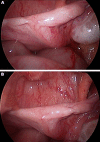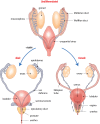Persistent Mullerian duct syndrome: a rare cause of unilateral cryptorchidism
- PMID: 22977013
- PMCID: PMC3534258
- DOI: 10.1136/bcr.02.2012.5722
Persistent Mullerian duct syndrome: a rare cause of unilateral cryptorchidism
Abstract
Persistent Mullerian duct syndrome (PMDS) is a rare syndrome and sometimes the cause of a common problem in paediatric and surgical practice, namely undescended testes. PMDS is a recessive disease in which there is a defect in anti-Mullerian hormone secretion or receptor activity resulting in persistence of Mullerian structures such as a uterus or fallopian tubes with otherwise normal virilisation. Here the authors present a case of a 1½-year-old boy who was referred to their hospital because of unilateral cryptorchidism. During laparoscopic surgery, two gonads were present joined together by a uterus-like structure. Additional investigations showed a normal male karyotype and biopsies of the gonads revealed infantile testis parenchyma making the diagnosis PMDS likely.
Conflict of interest statement
Figures


Similar articles
-
Combined persistent Mullerian Duct Syndrome, Transverse Testicular Ectopia and Mosaic Klinefelter's Syndrome.J Coll Physicians Surg Pak. 2008 Jun;18(6):375-7. J Coll Physicians Surg Pak. 2008. PMID: 18760051
-
[A case of persistent Mullerian duct syndrome diagnosed by laparoscopic examination for impalpable testis].Hinyokika Kiyo. 2012 Sep;58(9):507-9. Hinyokika Kiyo. 2012. PMID: 23070392 Japanese.
-
Persistent Müllerian duct syndrome (PMDS) presenting as bilateral cryptorchidism and left-sided inguinal hernia.BMJ Case Rep. 2024 Jul 23;17(7):e259784. doi: 10.1136/bcr-2024-259784. BMJ Case Rep. 2024. PMID: 39043463
-
[The persistent müllerian duct syndrome with transverse testicular ectopia. A hypothesis on the role of müllerian inhibiting factor in the process of testicular migration].Pediatr Med Chir. 1997 May-Jun;19(3):223-5. Pediatr Med Chir. 1997. PMID: 9340616 Review. Italian.
-
Surgical management of persistent müllerian duct syndrome.Urology. 1997 Jun;49(6):941-5. doi: 10.1016/s0090-4295(97)00104-0. Urology. 1997. PMID: 9187705 Review.
Cited by
-
Prostatic adenocarcinoma in a patient with persistent Müllerian duct syndrome.Urol Ann. 2022 Oct-Dec;14(4):398-402. doi: 10.4103/ua.ua_74_21. Epub 2022 Oct 17. Urol Ann. 2022. PMID: 36505994 Free PMC article.
-
Persistent Mullerian Duct Syndrome: a rare entity with a rare presentation in need of multidisciplinary management.Int Braz J Urol. 2016 Nov-Dec;42(6):1237-1243. doi: 10.1590/S1677-5538.IBJU.2016.0225. Int Braz J Urol. 2016. PMID: 27532119 Free PMC article. Review.
References
-
- Barthold JS, González R. The epidemiology of congenital cryptorchidism, testicular ascent and orchiopexy. J Urol 2003;170:2396–401. - PubMed
-
- Josso N, Belville C, di Clemente N, et al. AMH and AMH receptor defects in persistent müllerian duct syndrome. Hum Reprod Update 2005;11:351–6. - PubMed
-
- Lee MM, Misra M, Donahoe PK, et al. MIS/AMH in the assessment of cryptorchidism and intersex conditions. Mol Cell Endocrinol 2003;211:91–8. - PubMed
-
- di Clemente N, Belville C. Anti-Müllerian hormone receptor defect. Best Pract Res Clin Endocrinol Metab 2006;20:599–610. - PubMed
-
- Niewoehner CB. Endocrine Pathophysiology. Raleigh, N.C.: Hayes Barton Press; 2004.
Publication types
MeSH terms
LinkOut - more resources
Full Text Sources
Molecular Biology Databases
